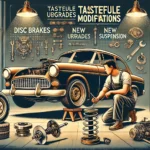Traveling long distances in a vintage car is a dream for classic car enthusiasts. The thrill of hitting the open road in a piece of automotive history makes the journey as exciting as the destination. However, planning a long road trip with a vintage car requires extra preparation and care. Here’s a comprehensive guide to ensure your adventure is smooth and memorable.
Step 1: Assess Your Car’s Condition
Before embarking on a long road trip, thoroughly assess your vintage car to ensure it’s roadworthy. A pre-trip inspection will help prevent unexpected breakdowns.
Key Inspection Areas:
- Engine and Transmission: Check for oil leaks, unusual noises, or performance issues.
- Brakes: Ensure the brake pads, fluid levels, and overall system are in optimal condition.
- Tires: Inspect for wear, proper inflation, and ensure you have a functional spare tire.
- Electrical System: Test the battery, alternator, and lights.
- Cooling System: Check the radiator, coolant levels, and hoses for leaks or damage.
If you’re not confident in your mechanical skills, consult a trusted mechanic who specializes in vintage cars.
Step 2: Create a Realistic Itinerary
Vintage cars are not built for speed or endurance like modern vehicles, so plan a relaxed itinerary with plenty of breaks.
Tips for Crafting Your Itinerary:
- Shorter Driving Days: Limit daily driving to 4-6 hours.
- Frequent Stops: Include stops every 1-2 hours for the car to cool down and for you to rest.
- Avoid Heavy Traffic: Stick to scenic routes and avoid congested urban areas.
- Plan for Unexpected Delays: Be flexible in case of breakdowns or detours.
Use apps like Google Maps or Waze to map out gas stations, mechanics, and accommodations along your route.
Step 3: Pack Smartly
Packing efficiently is crucial when traveling in a vintage car, as storage space is often limited.
Essentials to Pack:
- Tool Kit: Include wrenches, screwdrivers, a jack, and spare parts like belts and hoses.
- Fluids: Bring extra oil, coolant, and brake fluid.
- Emergency Kit: Pack a first-aid kit, flashlight, jumper cables, and a fire extinguisher.
- Snacks and Water: Stay hydrated and energized during the trip.
- Clothing: Dress in layers for comfort, as vintage cars often lack modern climate control.
- Navigation Tools: Carry a GPS device and paper maps as backups.
Step 4: Know Your Car’s Limits
Understanding your vintage car’s capabilities and quirks will help you avoid pushing it too hard.
Things to Keep in Mind:
- Speed: Most vintage cars are designed for lower speeds; stick to 50-60 mph.
- Terrain: Avoid steep hills or rough terrain that could strain the engine.
- Fuel Efficiency: Vintage cars often have lower fuel economy, so plan for frequent refueling stops.
Driving within your car’s limits ensures both safety and longevity.
Step 5: Prepare for Emergencies
Even with thorough preparation, unexpected issues can arise. Be ready to handle emergencies calmly.
Emergency Preparation Checklist:
- Roadside Assistance: Sign up for a service like AAA that caters to classic cars.
- Contact Numbers: Keep a list of mechanics along your route.
- Backup Transportation: Have a plan for alternative transport if your car breaks down.
Knowing you’re prepared for any situation will give you peace of mind.
Step 6: Choose the Right Season
The season you travel in can significantly affect your trip.
- Summer: Warm weather is ideal, but ensure your cooling system is in good shape.
- Spring/Fall: Mild temperatures are perfect for classic cars and make for comfortable drives.
- Winter: Avoid harsh winter conditions that can damage your car and make roads hazardous.
Check the weather forecast before leaving and adjust your plans if necessary.
Step 7: Embrace the Experience
One of the greatest joys of traveling in a vintage car is the journey itself. Take the time to enjoy the open road, stop at interesting locations, and meet fellow enthusiasts along the way.
Ways to Enhance the Experience:
- Document the Trip: Take photos of your car against scenic backdrops.
- Connect with Locals: Visit classic car clubs or events during your journey.
- Enjoy the Nostalgia: Appreciate the simplicity of vintage driving, free from modern distractions.
Final Tips for a Successful Trip
- Start Early: Hit the road in the morning to maximize daylight hours.
- Listen to Your Car: Pay attention to any unusual noises or performance changes.
- Stay Relaxed: Vintage cars are meant for slow, enjoyable drives—don’t rush.
With careful planning and the right mindset, a long road trip in a vintage car can be an unforgettable adventure. It’s not just about reaching your destination—it’s about savoring every mile along the way.








